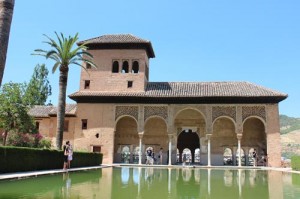 I am lucky enough to live quite near to the historic city of Granada in Andalucia, Spain, home of the beautiful Alhambra. I have visited it many times and each time I go I think of Catherine of Aragon, the first wife of Henry VIII, who spent time a couple of years there there before travelling to England to marry Prince Arthur.
I am lucky enough to live quite near to the historic city of Granada in Andalucia, Spain, home of the beautiful Alhambra. I have visited it many times and each time I go I think of Catherine of Aragon, the first wife of Henry VIII, who spent time a couple of years there there before travelling to England to marry Prince Arthur.
As I walk around the breathtaking Nasrid Palaces, the gardens with their citrus trees and water features, and gaze at the snow capped Sierra Nevada mountain range, it strikes me just how alien Catherine would have found London. In his biography of Catherine, Giles Tremlett describes how the Alhambra had “crystal-clear running water”, hot, warm and cold water in its bathrooms, white marble paving, and gardens of myrtle and lemon trees, and it was in a city known for its figs, pomegranates, citrus fruit, palms, olives, saffron, almonds, raisins, meat and trout. Hieronymus Munzer described how the Alhambra was made up of palaces with “superb coffered ceilings made of gold, lapis lazuli, ivory and cypress, in such a variety of styles that one cannot begin to explain or write about them” and how the gardens featured “springs, pools and charming little channels of water.” It was an idyllic pleasure palace and I cannot help but think that London would have been a huge disappointment and culture shock for the young Spanish princess.
The Alhambra, “red fortress”, is situated in Granada in the southern Spanish region of Andalucia, and is said to be the finest example of Moorish art. It has survived vandalism, earthquakes, neglect and destruction by countless rulers. There are references to this historic building dating back to the 9th Century, when the Arabs took refuge from the Christians in a red castle. In the 11th Century the castle ruins were rebuilt by Samuel ibn Naghralla (Samuel HaNagid), a king’s vizier in the time of the Zirid Dynasty.
The Alhambra that we know today was actually built during the Nasrid Dynasty of the 13th Century. The Nasrids made Granada a capital in their kingdom and the Alhambra became the official residence of the Nasrid royalty and court.
The famous Nasrid palaces in the Alhambra grounds date from this period. The Nasrid King Ibn al-Ahmar is famed for his irrigation system which diverted water from the rio Darro to provide water for the Generalife Gardens and its many water features.
Between the 13th and 15th centuries the Alhambra became a citadel protecting the Moors from the Christians.
Moorish rule came to an end in 1492 when King Ferdinand II of Aragon and Queen Isabella I of Castile defeated the Moors in the Granada region and took control of the Alhambra. The King and Queen made many damaging alterations but it was Emperor Charles V, in the 16th century, who did the greatest damage by demolishing parts of the Nasrid palaces to build his own renaissance style palace. After this date the Alhambra was largely forgotten and ignored. In the 18th century part of it was used as a prison and in 1812 it was looted and nearly blown up by the troops of Napoleon.
It was not until the 1830s, when writer Washington Irving moved into the palace rooms and wrote “Tales of the Alhambra”, that the Alhambra gained back its self-respect. Spain declared it as a national monument and work was begun on its restoration. This work continues today.
The Alcazaba
The Alcazaba is the fortress of the Alhambra and its first constructions date back to the Caliph period of the 7th and 8th centuries. The main fortress was built in the 11th century by Ziridian rulers.
When the Nasrids came to Granada, the Alcazaba was the only part of the Alhambra that existed. The first Nasrid king, Ibn al-Ahmar was responsible for the rebuilding of the fortress and made it into a great citadel with walls and towers. The Torre de la Vela ,or watchtower, gives amazing views over the Albaicin (the old Moorish quarter of Granada), the city and the mountains of the Sierra Nevada.
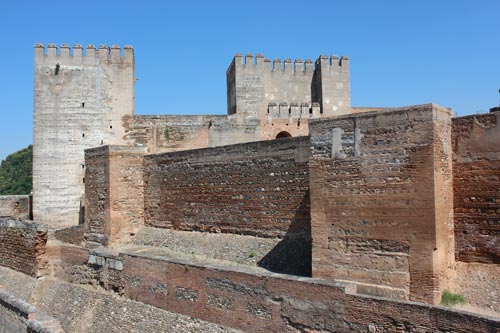
The Medina (the citadel)
This town, within the fortress of the Alhambra, had public baths and workshops, and also housed government officials and servants. It is here that you will find the Torre de las Damas (tower of the ladies) and the remains of the palace of Yusuf III. This citadel is now a street with restaurants and shops.
In the Medina there is also the 15th century Convent of San Francisco built by King Ferdinand on the site of a Moorish palace.
The Palace of Charles V
This Renaissance style palace was started in 1526 by the Holy Roman emperor Charles V but never completed. It consists of a palace with a circular courtyard, and now houses the two museums – the Museo de la Alhambra (full of artefacts) and the Museo de Bellas Artes (a gallery of paintings and sculptures). There is also a bookshop in the basement of the palace. What I find funny is that this palace is an ‘eyesore’ compared to the rest of the Alhambra. If it was located somewhere else, by itself, it would be a beautiful Renaissance piece of architecture, but it just does not fit in with the Moorish architecture of the fort and Nasrid Palaces.
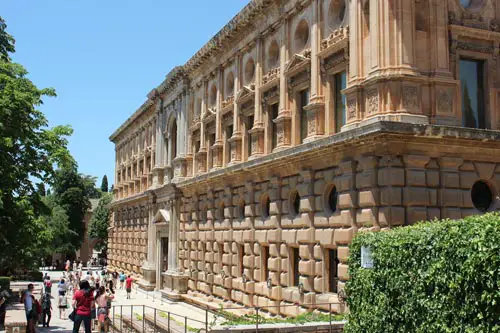
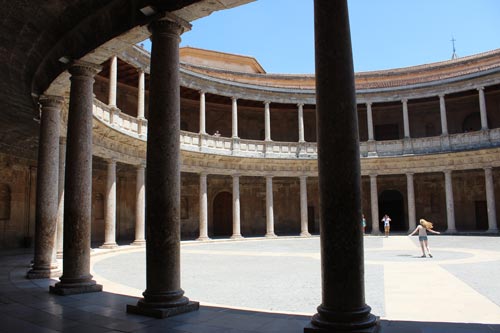
Nasrid Palaces
Unlike the stone fortress of the Alcazaba, these palaces were built by the Nasrids out of wood, brick and adobe. These palaces are famed for their ornate stucco decoration and Arabic inscriptions. The Nasrid palaces consist of three palaces:-
- The Mexuar – used by the sultans for business meetings and court.
- The Serallo or Yusuf I Palace with its marble columned arcades, used for receiving important guests.
- The Harem – the private living quarters. At the heart of the Harem is the Court of Lions or palace of Muhammad V. One of the famous photos of the Alhambra is of the lions supporting the fountain.
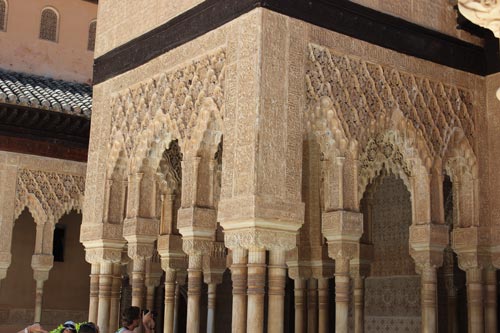
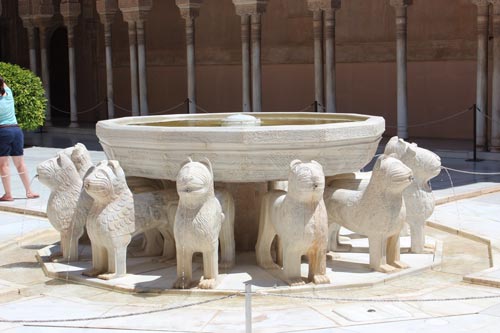
Generalife Gardens (Garden of the Architect)
Within these garden are the summer palace and gardens of the sultans. They consist of water features, orchards, gardens, patios and walkways. The gardens are amazing and are worth seeing at different times of year as they are completely different in different seasons. In one garden is the 700 year old trunk of a cypress tree which, according to legend, is where Sultana Zoraya would secretly meet with her lover.
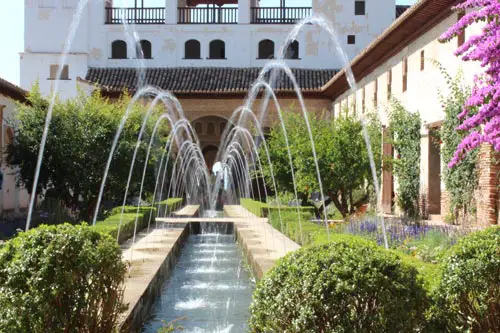
If you ever visit southern Spain then make sure you add Granada to your itinerary. Spend a day at the Alhambra and then another day visiting the Capilla Real (resting place of Ferdinand and Isabella), La Cartuja (Carthusian Monastery) and the Cathedral.
Here is a slideshow of photos from my visit to the Alhambra. All photos are copyright Tim Ridgway.
[slideshow id=548 w=300 h=300]